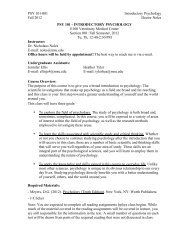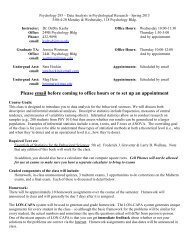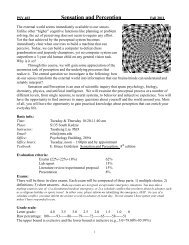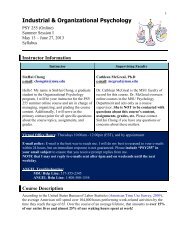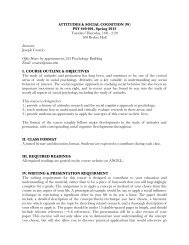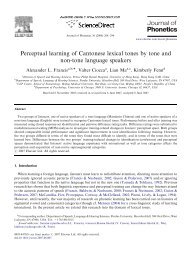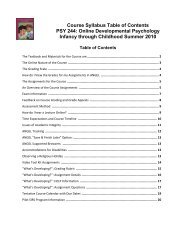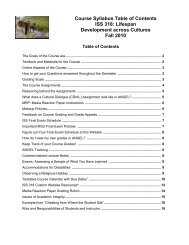Multidimensional Structure of the Hypomanic Personality Scale
Multidimensional Structure of the Hypomanic Personality Scale
Multidimensional Structure of the Hypomanic Personality Scale
You also want an ePaper? Increase the reach of your titles
YUMPU automatically turns print PDFs into web optimized ePapers that Google loves.
STRUCTURE OF THE HYPOMANIC PERSONALITY SCALE505reflecting aspects <strong>of</strong> both abnormal and normal functioning. If thiswere <strong>the</strong> case, <strong>the</strong>n one would expect <strong>the</strong> HPS to show associationswith multiple personality traits. Only a few studies have examined<strong>the</strong> relationship between <strong>the</strong> HPS and normal personality traits.Two studies have found small to moderate (.25 to .45) zero-ordercorrelations with <strong>the</strong> Big Five traits <strong>of</strong> Extraversion and Opennessto Experience but have found weak or no effects for <strong>the</strong> o<strong>the</strong>r threetraits (Furnham, Batey, Anand, & Manfield, 2008; T. D. Meyer,2002). The lack <strong>of</strong> association with Neuroticism is puzzling, giventhat <strong>the</strong> HPS predicts depressive episodes and severity (Klein etal., 1996; Kwapil et al., 2000). Several studies have focused on <strong>the</strong>role <strong>of</strong> individual differences in self-report measures <strong>of</strong> <strong>the</strong> BehavioralActivation (or Facilitation) System (Carver & White,1994), a broad neurobiological system hypo<strong>the</strong>sized to underliebipolar disorder (Depue & Iacono, 1989). HPS scores have beenfound to be positively associated with at least one BehavioralActivation System subscale (Reward Responsivity; B. Meyer,Johnson, & Carver, 1999; B. Meyer, Johnson, & Winters, 2001).However, Durbin, Schalet, Hayden, Simpson, and Jordan (2009)demonstrated that HPS scores were uniquely predicted by threehigher order traits—Extraversion, Openness, and Conscientiousness—andthat <strong>the</strong>se associations were evident over and aboveself-reported Behavioral Activation System scales.Taken toge<strong>the</strong>r, <strong>the</strong> heterogeneous content <strong>of</strong> <strong>the</strong> HPS items(shown in Table 1), its range <strong>of</strong> psychiatric and normal functioningcorrelates, and evidence that <strong>the</strong> HPS is correlated with three <strong>of</strong> <strong>the</strong>Big Five personality dimensions strongly suggest <strong>the</strong> presence <strong>of</strong>multiple group factors within <strong>the</strong> HPS. For example, <strong>the</strong> HPSpredicts both internalizing problems (such as depressive episodes)and externalizing disorders (e.g., substance abuse), which typicallyform distinct factors (Krueger, 1999; Vollebergh et al., 2001).Thus, it is possible that <strong>the</strong> overall scale score obscures groupfactors that may more cleanly account for <strong>the</strong> divergent correlates<strong>of</strong> <strong>the</strong> HPS. The estimate <strong>of</strong> reliability most commonly reported forstudies using <strong>the</strong> HPS is Cronbach’s alpha; however, althoughalpha indicates <strong>the</strong> extent to which a scale’s total score maycorrelate with some o<strong>the</strong>r measure, it tells us little about <strong>the</strong>unidimensionality versus multidimensionality <strong>of</strong> <strong>the</strong> scale (Revelle& Zinbarg, 2009).To date, efforts to elucidate <strong>the</strong> structure <strong>of</strong> <strong>the</strong> HPS haveincluded only two published structural analyses and one itemresponse <strong>the</strong>ory analysis. In <strong>the</strong>ir original study, Eckblad andChapman (1986) reported briefly on a principal components analysiswith varimax rotation, which yielded 12 components wi<strong>the</strong>igenvalues higher than 1. The first component accounted for14.3% <strong>of</strong> <strong>the</strong> variance and included 15 items (loadings above .3)that mostly measured hypomanic symptoms. The second factor(containing six items with factor loadings above .3) accounted for6.3% <strong>of</strong> <strong>the</strong> variance and seemed to reflect exhibitionism. Littlevariance was explained by each additional factor, leaving <strong>the</strong>structure <strong>of</strong> <strong>the</strong> additional 27 items unresolved. Of note, <strong>the</strong>orthogonal rotation precluded examination <strong>of</strong> whe<strong>the</strong>r <strong>the</strong> underlyingfactors were intercorrelated.Rawlings, Barrantes-Vidal, Claridge, McCreery, and Galanos(2000) analyzed three samples, using maximum-likelihood factoranalysis with promax rotation. The three samples produced somewhatdifferent factor structures; <strong>the</strong>se authors noted in <strong>the</strong>ir discussionthat <strong>the</strong>ir Spanish translation <strong>of</strong> <strong>the</strong> HPS (which was notindependently validated prior to <strong>the</strong> study) may have contributedto unreliable results for one <strong>of</strong> <strong>the</strong> samples. In addition, <strong>the</strong> secondsample, consisting <strong>of</strong> Australian participants, was relatively small(N 158) compared with <strong>the</strong>ir third sample (N 1,073) <strong>of</strong> Britishparticipants. Analyzing <strong>the</strong> British sample, Rawlings et al. foundthat four factors emerged (interpreting <strong>the</strong> Cattel scree plot), accountingfor 33% <strong>of</strong> <strong>the</strong> common variance in <strong>the</strong> HPS; <strong>the</strong> factorscorrelated moderately to weakly with one o<strong>the</strong>r. Rawlings et al.described <strong>the</strong>se factors as Moodiness, Cognitive Elements, Hyper-Sociability, and Ordinariness. Inspecting <strong>the</strong> pattern matrix table<strong>of</strong> <strong>the</strong> largest sample, one finds that <strong>the</strong> first factor clearly includes<strong>the</strong> hyperactivity and mood fluctuations characteristic <strong>of</strong> manicand hypomanic symptoms. The remaining factors are more difficultto interpret. For example, <strong>the</strong> second factor contained a mix <strong>of</strong>cognitive capacity items (“Sometimes ideas and insights come tome so fast that I cannot express <strong>the</strong>m all”) and social potency items(“I have an uncommon ability to persuade and inspire o<strong>the</strong>rs”).The Ordinariness (fourth) factor contained only reverse-codeditems, suggesting that wording polarity likely influenced factorextraction. The first factor dominated <strong>the</strong> scale, with 19 itemsloading higher than .3. The remaining factors had approximatelyeight items, each loading greater than .3; six did not load higherthan .3 on any factor. Given <strong>the</strong> number <strong>of</strong> low loadings, a highlevel <strong>of</strong> uniqueness may be associated with each item. Finally, itshould be noted that nei<strong>the</strong>r Rawlings et al. nor Eckblad andChapman (1986) validated <strong>the</strong> factors against any criterion measures.Finally, Meads and Bentall (2008) applied a Rasch model (oneparameteritem response <strong>the</strong>ory) to a sample <strong>of</strong> 318 students whocompleted <strong>the</strong> HPS. This produced a 20-item unidimensional scaleafter redundancies and misfitted items were eliminated. The 20-item version and <strong>the</strong> original full scale had similar correlationswith symptoms <strong>of</strong> depression, rumination, and reports <strong>of</strong> dangerousactivities. A potential problem with this approach is thatmeaningful group variance may be eliminated when <strong>the</strong> aim is toproduce a single scale with one dimension, ra<strong>the</strong>r than to explicitlymodel <strong>the</strong> empirical structure <strong>of</strong> <strong>the</strong> items.The present study represents an attempt to clarify <strong>the</strong> structure<strong>of</strong> <strong>the</strong> HPS, improving on some <strong>of</strong> <strong>the</strong> analytic procedures <strong>of</strong>previous studies and validating this structure with a range <strong>of</strong>important criterion variables. One challenge to this aim is <strong>the</strong>dichotomous response format <strong>of</strong> <strong>the</strong> HPS. Dichotomous items maybe prone to factor or cluster toge<strong>the</strong>r on <strong>the</strong> basis <strong>of</strong> equal endorsementprobability (Ferguson, 1941; Panter, Swygert, Dahlstrom,& Tanaka, 1997). For example, two items can achieve aperfect correlation only if <strong>the</strong>ir endorsement probabilities are alsoequal. Because items may be endorsed according to thresholds inaddition to content, any analytic procedure that depends on interitemcorrelations may overestimate <strong>the</strong> number <strong>of</strong> factors andunderestimate <strong>the</strong> factor loadings. One improvement is to estimatetetrachoric correlations on <strong>the</strong> basis <strong>of</strong> <strong>the</strong> item intercorrelations(Divgi, 1979; Wherry & Gaylord, 1944).Like factor analysis, hierarchical cluster analysis can be used toexplore <strong>the</strong> structural relationship among items (Bacon, 2001;Revelle, 1979; Tate, 2003; van Abswoude, Vermunt, Hemker, &van der Ark, 2004). One type <strong>of</strong> hierarchical cluster analysis,ICLUST (Revelle, 1979) follows a four-step algorithm in whichestimates <strong>of</strong> reliability form <strong>the</strong> basis for clustering decisions. In<strong>the</strong> first step, <strong>the</strong> two items with <strong>the</strong> highest corrected correlationare combined. As small clusters are matched on <strong>the</strong> basis <strong>of</strong> <strong>the</strong>




